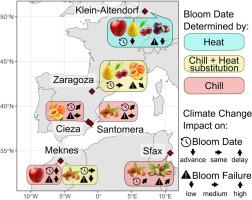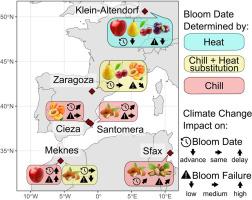对比对气候变化的响应——预测地中海地区和中欧主要温带树种开花
IF 5.7
1区 农林科学
Q1 AGRONOMY
引用次数: 0
摘要
气候变化正在改变温带树木叶片出芽和开花的时间。虽然变暖通常会促进春季物候,但冬季寒冷不足会延迟或阻止开花。了解物种和栽培特有的反应对于适应规划至关重要。我们利用来自西班牙、突尼斯、摩洛哥和德国的7种温带水果和坚果树种(苹果、梨、杏、甜樱桃、李子、杏仁、开心果)的110个品种的长期开花数据,对PhenoFlex物候学模型进行了校准。模型利用14-18个环流模式,在当前(2015年)和未来两个时间段(2035-2065年、2070-2100年)和4个变暖情景(SSP1-2.6、SSP2-4.5、SSP3-7.0、SSP5-8.5)下,预测了花期和潜在的花期失效(当农业气候要求未得到满足时)。出现了三个关键趋势:德国的开花日期提前,西班牙南部、突尼斯和摩洛哥的大多数物种开花日期推迟,西班牙北部和摩洛哥的杏仁开花日期基本不变。开花时间的不同主要驱动因素导致了开花时间的不同:开花提前的地方有热,开花延迟的地方有冷,开花静止的地方有冷和热替代。在短期内(2035-2065),除了西班牙南部的杏子和突尼斯中部的开心果外,大多数品种的农业气候要求预计将得到满足。在悲观的长期变暖情景下(2070-2100年),预计突尼斯、摩洛哥和西班牙南部大多数物种的开花失败率飙升,而西班牙北部的失败率则较小。我们的研究结果揭示了不同品种在开花日期变化和失败率上的差异,表明不同品种对冬季增温的适应性存在差异。这些信息可以指导根据栽培品种与预测的农业气候条件的一致性来设计具有气候适应性的果园。本文章由计算机程序翻译,如有差异,请以英文原文为准。


Contrasting responses to climate change – predicting bloom of major temperate fruit tree species in the Mediterranean region and Central Europe
Climate change is shifting the timing of leaf emergence and bloom in temperate-zone trees. While warming typically advances spring phenology, insufficient winter chill can delay or prevent bloom. Understanding species- and cultivar-specific responses is vital for adaptation planning. We calibrated the PhenoFlex phenology model using long-term bloom data for 110 cultivars of seven temperate fruit and nut tree species (apple, pear, apricot, sweet cherry, plum, almond, pistachio) across Spain, Tunisia, Morocco and Germany. The models projected bloom dates and potential bloom failure – when agroclimatic requirements are not met – under current (2015) and future scenarios for two time periods (2035–2065, 2070–2100) and four warming scenarios (SSP1–2.6, SSP2–4.5, SSP3–7.0, SSP5–8.5), using 14–18 General Circulation Models. Three key trends emerged: advancing bloom dates in Germany, delayed bloom for most species in southern Spain, Tunisia, and Morocco, and largely unchanged bloom dates in northern Spain and for almonds in Morocco. The contrasting shifts in bloom result from differences in the primary driver of bloom timing: heat where bloom advances, chill where bloom is delayed and chill and heat substitution where bloom is stationary. In the short term (2035–2065), agroclimatic requirements for most species are expected to be met, except for apricots in southern Spain and pistachios in central Tunisia. Predicted bloom failure rates spiked for most species in Tunisia, Morocco, and southern Spain under pessimistic warming scenarios in the long term (2070–2100) and, to a lesser extent, in northern Spain. Our results reveal cultivar-specific differences in bloom date shifts and failure rates, indicating variation among cultivars in their adaptability to winter warming. This information may guide the design of climate-resilient orchards based on cultivars’ alignments with projected agroclimatic conditions.
求助全文
通过发布文献求助,成功后即可免费获取论文全文。
去求助
来源期刊
CiteScore
10.30
自引率
9.70%
发文量
415
审稿时长
69 days
期刊介绍:
Agricultural and Forest Meteorology is an international journal for the publication of original articles and reviews on the inter-relationship between meteorology, agriculture, forestry, and natural ecosystems. Emphasis is on basic and applied scientific research relevant to practical problems in the field of plant and soil sciences, ecology and biogeochemistry as affected by weather as well as climate variability and change. Theoretical models should be tested against experimental data. Articles must appeal to an international audience. Special issues devoted to single topics are also published.
Typical topics include canopy micrometeorology (e.g. canopy radiation transfer, turbulence near the ground, evapotranspiration, energy balance, fluxes of trace gases), micrometeorological instrumentation (e.g., sensors for trace gases, flux measurement instruments, radiation measurement techniques), aerobiology (e.g. the dispersion of pollen, spores, insects and pesticides), biometeorology (e.g. the effect of weather and climate on plant distribution, crop yield, water-use efficiency, and plant phenology), forest-fire/weather interactions, and feedbacks from vegetation to weather and the climate system.

 求助内容:
求助内容: 应助结果提醒方式:
应助结果提醒方式:


